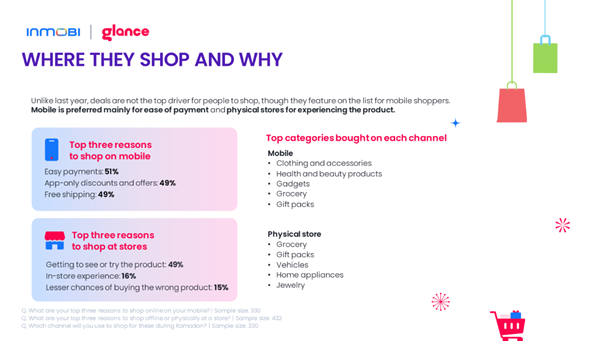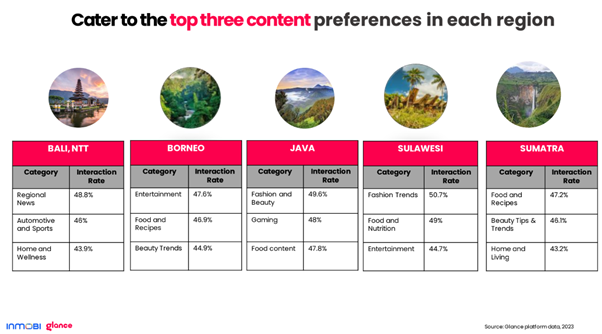With Indonesia’s diverse shopper profiles and preferences, as well as increased travel and spending during Ramadan, InMobi’s Vasuta Agarwal says the holy month presents marketers with many opportunities.
Marketers across Southeast Asia already know that Ramadan is an exciting opportunity for brands to connect with consumers in the region. They will also know that each market has its nuances when it comes to spending habits. However, perhaps less well-known is the reality that even within a single market, there can be significant differences in shoppers’ preferences.
To help understand how marketers can ensure the effectiveness of marketing throughout the Ramadan period, InMobi and Glance conducted a deep dive into the shopping habits of consumers in Indonesia, the most populous Muslim country. It confirmed that whilst shopping research and purchases are spiking across the whole region, regional marketers should be cautious about applying a one-size-fits-all strategy. Here’s why.
Different shopping styles
There are three main categories of shoppers during Ramadan in Indonesia.
- The unplanned shoppers (17%) are undecided on products and brands and keen to explore the biggest deals. They are more likely to be older consumers, with 61% having budgets under Rp 3 million.
- The category explorers (68%) have decided on the products they want to purchase but are still actively exploring which brands to buy. These are more likely to be younger consumers, with 59% having budgets over Rp 3 million.
- The brand lovers (15%) have already decided on brands and are loyal to their favorites. These are typically older consumers and 45% have budgets over Rp 5 million.
Consequently, marketers should plan campaigns around these three key stages in the shopping journey. For example, when we looked closely at category explorers and brand lovers, we found that their shopping peaked two weeks before Ramadan, whilst the unplanned shoppers expected to shop throughout the season and were highly influenced by the temptation of deals.

Mobile-first: A critical strategy
One commonality is that mobile is everything when it comes to marketing during Ramadan. Digital channels corner the lion’s share of spend and attention, with 96% of shoppers reporting that digital mediums are an important part of their shopping journey.
The main reasons for this include easy payments, app-only discounts and offers, as well as free shipping. Spending is also surging – 60% of Indonesians report an increase in their online shopping budgets, versus 41% for offline.
Mobile is also, by far, the biggest platform for research (97%), followed by physical stores (62%) and just 34% on desktop. Consumers are increasingly spoilt for choice with many online brands and products available, and they are actively exploring their options – 85% stated they had yet to decide the brand they would like to buy from, the products to purchase, or both. This creates a critical opportunity for marketers to target and win new buyers, ideally through creating a seamless, serendipitous, single-tap experience on the mobile’s first touchpoint.

Media: Diverse content choices
Whilst a smooth mobile experience is the ideal marketing strategy across Indonesia, the content consumed via mobile varies throughout the region. Over 30 million people are active users of smartphone lock screen Glance and consume an incredible two million hours of content each month. This gives an unprecedented insight into the types of content consumed across the region and demonstrates the regional variation.

For example, in Bali, regional news is by far the most popular category, with nearly half of Balinese (48.8%) viewing it. This is followed by automotive and sports (46%), and home and wellness (43.9%).
By contrast, fashion trends and beauty are most popular in Java (49.6%) and Sulawesi (50.7%), ranking second in Sumatra and third in Borneo. Borneo’s top category is entertainment (47.6%), followed by food and recipes (46.9%).
Marketers should therefore align their category media spend and marketing messages according to local preferences.
Mudik: A passion for travel
Mudik, the traditional trip to visit loved ones before the holidays, is a significant trend during Ramadan. Nearly three-quarters (74%) of Indonesians plan to travel back to their hometown this Ramadan. Given Indonesia is the fourth most populous country in the world, this is a phenomenal movement of people.

The surge in mudik travel highlights the significance of Ramadan as a time of giving and self-renewal across Indonesia. It also means increased spending on travel, gift-buying and charity. Overall, clothing and accessories (89%) is the top category, followed by grocery (71%) and gift packs (70%).
The timing of these messages also matters. Whilst 22% of Indonesians will travel before or during the start of Ramadan, travel will spike during the last week of Ramadan itself (41% plan to travel), with 20% travelling on the actual day of Idul-Fitri. Here, marketers can reach the three main categories of Ramadan shoppers with timely and relevant marketing messages and offers.
For marketers who can understand the nuances of this populous nation, there is a significant opportunity to tap into Ramadan-specific moments with highly relevant and engaging mobile marketing campaigns.

